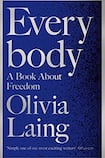
Olivia Laing has made her name as a writer of hybrid books of criticism, memoir, travelogue and biography. In To the River, her first book, she used a break-up and the loss of a job as spurs to walk the length of the river Ouse in Sussex while considering the life and work of Virginia Woolf, who drowned there in 1941. The Trip to Echo Spring draws on her life growing up in a household “under the rule of alcohol” to examine the lives of alcoholic writers.
Laing’s third – and breakout – book, The Lonely City, is an investigation of urban loneliness, through the lens of artists such as Edward Hopper and Andy Warhol, and her own experience of being alone and heartbroken in New York City.
The formula works for her. Thus it is with her latest book of nonfiction, although she chooses a new theme, that of “bodies in peril and bodies as a force for change”. She adopts a similar approach – an adeptly braided mix of cultural criticism, biography, and memoir – to explore the body from multiple perspectives, most particularly as a potential locus of freedom in what continues to be a constricted world.
Laing often settles on a central character, through whom she then channels her analysis. In The Lonely City, it was the then under-known artist and writer David Wojnarowicz, who died of Aids in 1992 and whose reputation Laing did much to restore. In Everybody it is the renegade psychoanalyst Wilhelm Reich, a disciple of Sigmund Freud, who came of age in his profession in 1920s Vienna, where he began to recognise the body as a site of traumatic memory, and sex as its great liberator.
Reich’s The Function of the Orgasm (1926) argues that the orgasm is a magical biological transaction, a mysterious route by which the psyche restored itself to equilibrium. His theories, as well as his outspoken anti-fascism, forced a split with Freud. In 1939, with the Nazis at his back for the triple crime of being a Jew, a communist and a prominent sex reformer, Reich fled Europe for the US, where he grew isolated and paranoid, exiled from everything he knew and loved, increasingly suspicious of the sexual freedom he had once espoused.
For Laing, Reich’s story is instructive. His journey from utopian believer in sex as the key to emotional and physical health in prewar, sexually liberated Austria and Germany (so long, that is, as the sex was heterosexual: there were, writes Laing, limits to his radicalism) to a lonely, drunk bully, hunted out of Berlin by the Third Reich, then stalked by the US Food and Drug Administration in the wide-open spaces of Eisenhower’s conservative America, demonstrates the impact of power and suffering on the site of the body.
Reich’s response to his own trauma was to withdraw from the outside world: he spent his later years building his “orgone accumulator”, a machine the size of a small cupboard, inside which people would sit alone and get a blast of their own energetic resources. This, writes Laing, was a mistake. “There is no steel-lined box that can protect you from the grid of forces that limits in tangible, tormenting ways what each private body is allowed to be or do,” she says. “Either you submit to the world or you change the world. It was Reich who taught me that.”
Reich did try to change the world, but then the world beat him down. He is at the heart of Laing’s investigations, but her course also takes her through the lives and work of others who tried – and so often failed – to find bodily freedom.
There is the artist Ana Mendieta, who used her body to make work that exposed sexual violence against women; the writer and radical feminist Andrea Dworkin, who campaigned against pornography; Susan Sontag, who wrote Illness Is a Metaphor as a rebuttal against the stigma of terminal illness, but who secretly feared that her cancer was her own fault.
Laing once had a career as herbal medicinist, and she lived for a time in the hedonistic Brighton of the 1990s; these experiences also feed into her inquiry. As a writer, she does what she does extremely well, tripping lightly over her meld of genres, unafraid of independent thought and criticism, but unafraid, also, of nuance, uncertainty, and empathy for polarising characters such as Reich, Dworkin, even Freud.
She reminds me, that way, of a writer such as Maggie Nelson, turning her considerations around and round, holding them up, looking at them in the light. Writing, for example, of her discomfort with her gender – “I’d always felt like a boy inside, a femme gay boy” – she also voices her scepticism at the “notion of two rigidly opposed genders”, whereby even trans people must always be on their way from one gender to the other. “What I wanted as a trans person,” she writes, “is to escape the binary altogether.”
In a world where she finds herself increasingly fearful, afraid of the melting icecaps, of the drastic inequalities, of the newspaper stories of bodies brutalised, Laing has written this book in a bid for such an escape.
She is not utopian or idealistic about this. “A free body,” she writes, “need not be whole or undamaged or unaugmented.” But it might be one without fear. With such a body, says Laing, imagine what kind of world we could build.











